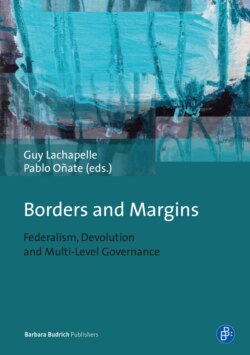Читать книгу Borders and Margins - Группа авторов - Страница 17
На сайте Литреса книга снята с продажи.
Overview
ОглавлениеWe will begin in section I with a theoretical overview of the literature covering what “multilevel governance” (MLG) is understood to mean and what its [33] underlying causes are considered to be in general theoretical terms and in a broad international context. We will also review the literature evaluating the relative strengths and weaknesses of this concept in comparison to related concepts like “federalism” and “centralised unitarism” when applied to an analysis of internal intergovernmental relations. We will then examine some of the more important theoretical contributions and insights provided in recent years drawing in particular on Fritz Scharpf (2009), Simona Piattoni (2009-2010), and Theo A.J. Toonen (2010), a contributor to an edited volume by Edoardo Ongaro et al. (2010).
In section II we will compare in brief schematic form efforts at reform of internal intergovernmental relations and rebalancing of national-regional power relations in the United Kingdom and Germany since the early 1990s within the broad parameters of our summary in the preceding section of recent theoretical contributions to MLG theory. And in section III, our concluding section, we will redefine our evolving argument and position on multilevel governance theory in light of the schematic comparative empirical analysis of recent reforms in the UK and Germany conducted in the preceding section (section II) of this paper.
Pros and Cons of MLG versus other more traditional approaches to European Governance MLG versus neo-functionalism and neo-institutional intergovernmentalism: positive and negative contributions:
There has been much academic debate about the value of “multilevel governance” (MLG) as an analytical construct applied to internal intergovernmental relations, and its relative merits and shortcomings in comparison to earlier concepts and approaches to European integration such as “neo-functionalism” and “neo-institutional íntergovernmentalism.” The concept of “multilevel governance” was first applied descriptively in the early 1990s to the evolving political system of the European Union. Many specialists in European politics argued then that this concept and its related theoretical attributes constituted an important advance on two major earlier approaches that had been applied to European integration up to that point: neo-functionalism and neo-institutional or state intergovernmentalism. They also viewed it as a more accurate device for describing global trends in the economy and politics of advanced industrial countries in the late twentieth and early twenty-first centuries. They contended that MLG describes more realistically and precisely than its theoretical antecedents and competitors the complex and gradually evolving state/social, centre/periphery (territorial), and domestic/international relationships that have shaped European political developments, especially since the signing of the Maastricht Treaty in 1992. MLG is viewed as a more “actororiented” portrayal and a more “flesh and blood” representation of the causal forces underlying economic and political integration than the neo-functionalist dynamic. It is also considered to subsume more fully and depict more accurately the major role now played by non-state actors and agents in policy and [34] political decision-making processes in Europe than the state intergovernmentalist approach (Piattoni 2009: 3, citing Marks 1992).
Other analysts, on the other hand, have been much more critical of this concept. They claim that it is narrowly descriptive rather than broadly analytical (Bache 1998), too generally or ambiguously defined and conceptually “overstretched beyond usefulness” (Piattoni 2009, citing Sartori 1970), and too dismissive or neglectful of the dominant “gate-keeping” function of national governments (Moravcik 1993). Still others complain that it is a highly complex and multidimensional analytical device that is very difficult to use (Piattoni 2009: 7), that it exaggerates the post- and extra-constitutional nature of the forms and processes that it encompasses (Peters 2000), and that it accepts some highly debatable assumptions about the normative benefits that it contributes in its political problem-solving capacity (Scharpf 1997), or in the compromises it promotes (Pierre and Peters 2002).
